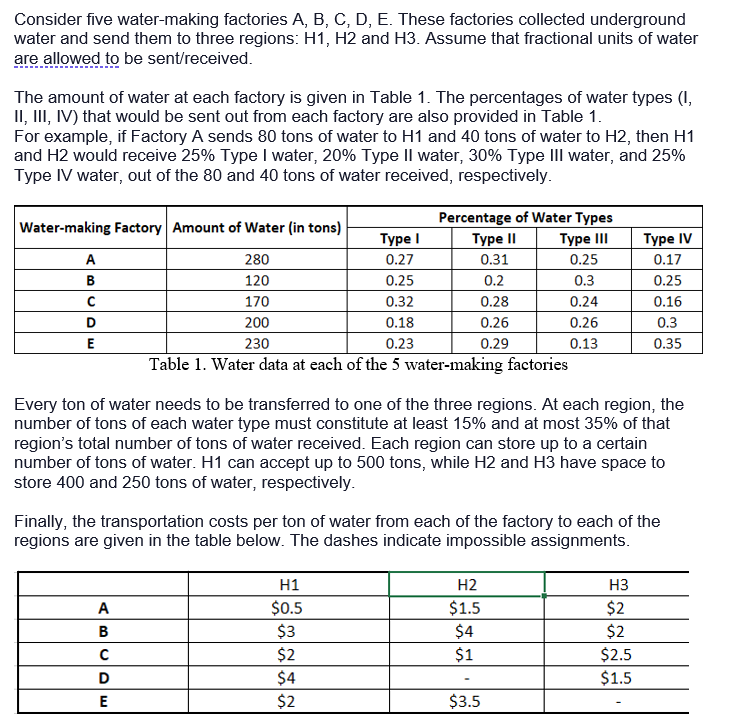Question
You are hired to help determine the optimal amount of water (in tons) that should be transferred from each factor to each region while minimizing

You are hired to help determine the optimal amount of water (in tons) that should be transferred from each factor to each region while minimizing the total transportation cost and meeting the above-mentioned requirements.
Question 1: Formulate a linear programming model for this problem. Use the following decision variable in your model:
= tons of water sent from factory to region
Question 2:
Your boss has decided to remove H2 from their distribution list. In that case, the Factory E would be able to transport blood units to H3 with a given cost of 3 per unit. This change would also result in an increase in the capacity of H1 to 600 and H3 to 500. Revise the model in Question 1 to accommodate these changes.
Question 3:
After you presented your findings, your boss would like to see a solution where each factory only transfers all the water to a single region. They are aware that this may cause the infeasibility of some of the previous constraints. Adjust your recommendation in so that each factory is assigned to only one region. Which constraints would be violated and need to be removed? How would the solution and total cost change? PS: Do not solve the model again, rather provide a solution by inspection based on the solution you found in part 1.
Consider five water-making factories A, B, C, D, E. These factories collected underground water and send them to three regions: H1, H2 and H3. Assume that fractional units of water are allowed to be sent/received. The amount of water at each factory is given in Table 1. The percentages of water types (I, II, III, IV) that would be sent out from each factory are also provided in Table 1. For example, if Factory A sends 80 tons of water to H1 and 40 tons of water to H2, then H1 and H2 would receive 25% Type I water, 20% Type Il water, 30% Type III water, and 25% Type IV water, out of the 80 and 40 tons of water received, respectively. Water-making Factory Amount of Water (in tons) Percentage of Water Types Type Type II Type III A 280 0.27 0.31 0.25 B 120 0.25 0.2 0.3 170 0.32 0.28 0.24 D 200 0.18 0.26 0.26 E 230 0.23 0.29 0.13 Table 1. Water data at each of the 5 water-making factories Type IV 0.17 0.25 0.16 0.3 0.35 Every ton of water needs to be transferred to one of the three regions. At each region, the number of tons of each water type must constitute at least 15% and at most 35% of that region's total number of tons of water received. Each region can store up to a certain number of tons of water. H1 can accept up to 500 tons, while H2 and H3 have space to store 400 and 250 tons of water, respectively. Finally, the transportation costs per ton of water from each of the factory to each of the regions are given in the table below. The dashes indicate impossible assignments. H3 A B D E H1 $0.5 $3 $2 $4 $2 H2 $1.5 $4 $1 $2 $2 $2.5 $1.5 $3.5 Consider five water-making factories A, B, C, D, E. These factories collected underground water and send them to three regions: H1, H2 and H3. Assume that fractional units of water are allowed to be sent/received. The amount of water at each factory is given in Table 1. The percentages of water types (I, II, III, IV) that would be sent out from each factory are also provided in Table 1. For example, if Factory A sends 80 tons of water to H1 and 40 tons of water to H2, then H1 and H2 would receive 25% Type I water, 20% Type Il water, 30% Type III water, and 25% Type IV water, out of the 80 and 40 tons of water received, respectively. Water-making Factory Amount of Water (in tons) Percentage of Water Types Type Type II Type III A 280 0.27 0.31 0.25 B 120 0.25 0.2 0.3 170 0.32 0.28 0.24 D 200 0.18 0.26 0.26 E 230 0.23 0.29 0.13 Table 1. Water data at each of the 5 water-making factories Type IV 0.17 0.25 0.16 0.3 0.35 Every ton of water needs to be transferred to one of the three regions. At each region, the number of tons of each water type must constitute at least 15% and at most 35% of that region's total number of tons of water received. Each region can store up to a certain number of tons of water. H1 can accept up to 500 tons, while H2 and H3 have space to store 400 and 250 tons of water, respectively. Finally, the transportation costs per ton of water from each of the factory to each of the regions are given in the table below. The dashes indicate impossible assignments. H3 A B D E H1 $0.5 $3 $2 $4 $2 H2 $1.5 $4 $1 $2 $2 $2.5 $1.5 $3.5Step by Step Solution
There are 3 Steps involved in it
Step: 1

Get Instant Access to Expert-Tailored Solutions
See step-by-step solutions with expert insights and AI powered tools for academic success
Step: 2

Step: 3

Ace Your Homework with AI
Get the answers you need in no time with our AI-driven, step-by-step assistance
Get Started


